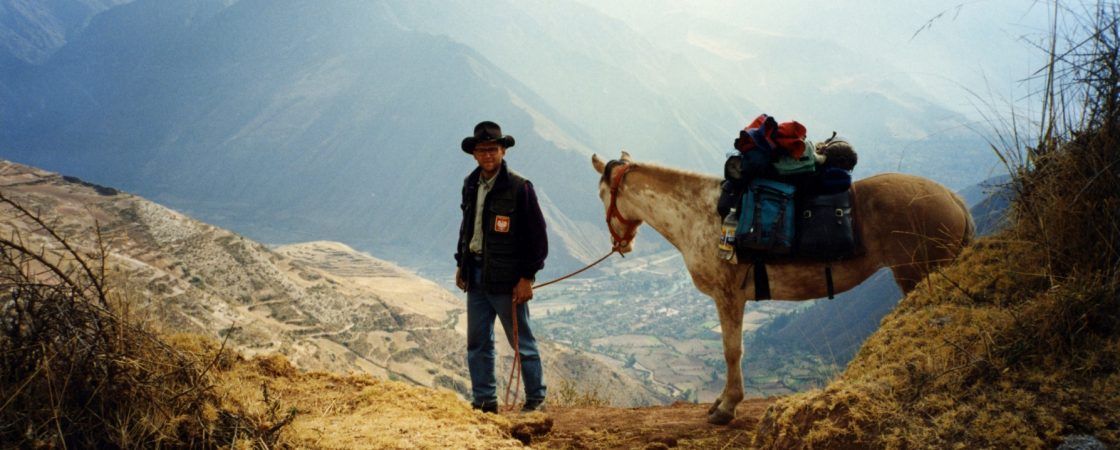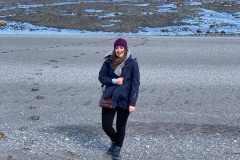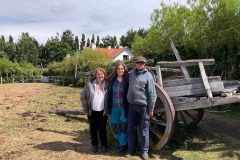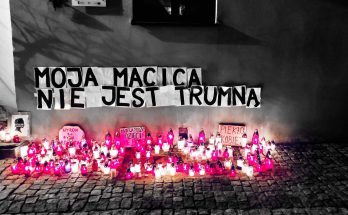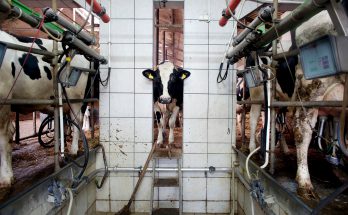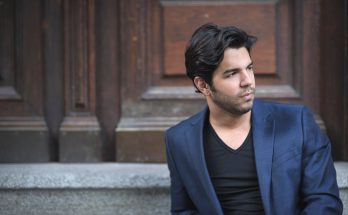I came across the story of Wiktoria’s journey in the footsteps of her father, Tadeusz Kotwicki, just when I was reading Paul Theroux book The Old Patagonian Express. Paul’s journey begins in 1978 with the Boston subway and ends in Tierra del Fuego, after having travelled thousands of kilometers on countless dilapidated and beat-up trains.
Tadeusz Kotwicki travelled in 1995 in exactly the opposite direction. Unlike Paul Theroux, who went alone, he had an excellent companion — the mare called Dot. Both, however, missed their families in the same way. In the case of Tadeusz Kotwicki, thanks to this longing, we can learn about the details of this expedition at all, as they have been preserved in letters to his wife.
His journey from Patagonia to Colombia is called the longest lonely horseback trip of the modern era. Jacek Kobus writes on his blog that “if anyone could compare to him in the past, it must have been a long time ago, maybe in the times of Genghis Khan and his direct successors, when some people probably travelled many times across the Great Steppe, from the shores of the Pacific to the Black Sea”. Some also compare it to Kazimierz Nowak and his African peregrinations in the 1930s. These comparisons are not surprising, especially if we know that the planned journey was supposed to be much longer. The idea was that the route on horseback would lead from the Strait of Magellan to the Bering Strait. The reality turned out to be a bit different.
In 1995 Tadeusz Kotwicki lands in Buenos Aires with money to buy a horse. From there, he takes a bus to the shore of the Magellan Strait, and then moves on foot. With him he has a backpack and a saddle he had designed himself. Only in the province of Santa Cruz does he end up at a ranch, where he stops for some time to tame a horse he bought there… Together with his new companion, the mare Dot, he rides through Argentina, Bolivia, Peru, Ecuador and Colombia, thus covering 10,500 km. Forced by circumstances, he leaves the horse under the care of a family he met literally on the road, a family which shows him a lot of kindness. He travels the rest of the way by bike and later on horseback again. His journey ends in Kansas City in 1997. From there, Kotwicki, motivated by longing and other circumstances, returns to his family, to Wrocław, which was hit by a great flood that year.
A minimalist journey out of the heart’s need. No money, no sponsorship, no special equipment, no media coverage, no selfie spots, no Internet access. Kotwicki and Dot travel through South America for over a year, receiving help from people he meets, making new friends and writing letters home. Today, when speed and quantity count more than quality, where the image of many travelers is created by sponsors and social media, and the success of the expedition depends on the number of likes, one can rarely meet a traveler of this caliber anymore. Still unanswered is the question of how is it possible that so few people know this man and have heard about his expedition. I hope that this will change soon, mostly due to the trip of Wiktoria Kotwicka she makes over twenty years later.
Zuzanna Majer: How did it happen that a young lawyer from Lower Silesia decided to suspend her career and all other matters, and leave for South America for a few months? Did you plan this trip for years or did you act on impulse?
Wiktoria Kotwicka: The thought of going to South America has accompanied me for a long time. Actually, since the beginning of my studies. During the summer break after the first year, I went to work abroad and earned my first “big” money. I then thought I might spend it on such a trip. I knew, however, that I had to grow up and be ready for this journey – after all, it was not just about a simple trip, but about finding witnesses to my father’s journey. One about which so little was said at home, but which was told though photos that had been hanging in the living room for years. This story functioned a bit like a family myth that fascinated me since I was a child. My emaciated Dad, losing his battle against cancer, told me at the end of his life how often he prayed the rosary during his expedition. He did not manage to tell much more… In my third year I went to Spain for an exchange to learn Spanish. I knew that one day I would need it, I just didn’t know when. After graduation, I decided to take the bar exam. Like most of my friends, I got a job and started preparing for the exam. And it was during this period that I thought more and more often about the fact that since I had closed a certain chapter in my life and have no serious commitments, maybe this was the best time to discover the history of Dad’s expedition. I think I felt like I was ready. I had been agonizing for so long that despite being his daughter I knew so little about this extraordinary journey…. I also found it disturbing that the records from the expedition are disordered and forgotten. And so when I found out that I had been accepted to the application — then the impulse came. It may seem strange, but that’s when I decided to take a year off.
ZM: Let’s start with a chronology of events. In January 2019 you flew to Patagonia and what happened next? How did you travel and how much time did you spend following in the footsteps of your dad?
WK: Yes, my adventure started in January. Although it was really in October. That’s when I started to read Dad’s letters to Mom, his diary, to discover things I had no idea about. I knew I had to organize the photos. What worried me the most was that I wouldn’t be able to put photographs in context, that after Dad’s death this knowledge was lost. And then it turned out that Dad, together with the photographic films in his letters to Mom, had been sending short descriptions of them. I remember that it calmed me down remarkably. I felt grateful that Dad had taken care of this detail. It was precisely this time spent reading the diary and putting together the films that was a very important introduction to my journey in Dad’s footsteps, which can be divided into two stages. The first stage was to get to the place where Dad started the expedition, i.e. to the southern tip of South America to Patagonia. The second stage was Colombia – the place where the expedition of the extraordinary duo ended. I flew to Patagonia in mid-January. I spent 3 weeks there. After that time I returned to Poland and then I flew back to South America in the middle of March, this time for much longer. I spent four months in Colombia.
ZM: Your primary goal in Argentina was to reach the Stag River estancia, where Tadeusz Kotwicki bought Dot. How did you manage to find it and what was the contact with the owners like before you arrived? From your account I understood that you became friends?
WK: It’s true — the Stag River estancia was my destination. I found the Johnston family on Facebook through their farm website. I contacted them in December by email. I remember I wrote a long email explaining who I was and… that I am flying to Argentina in January. And that of course I would love to visit them. Their reaction was very kind, they didn’t hesitate to invite me, but they weren’t too effusive. In fact, we didn’t have much contact before my arrival. Just a few messages. But once I got there, we talked a lot. My Spanish was of no use because it turned out that Mr. and Mrs. Johnston were Scots and spoke English very well. Even though Dad only spent a few days with them, I felt I wasn’t a stranger there. When I arrived at their home in the Patagonian wilderness, our first meeting was accompanied by very strong feelings. I was crying, Robin and Juliet also had tears of emotion in their eyes. It was clear that they were very excited. I spent only 5 days with them, but that was enough to strengthen the bond that was born years ago with the unexpected visit of a Pole who wanted to cross the Americas on a horse from their breeding.
ZM: In Colombia you visited the Colombian family, with whom your dad left his companion and saddle (and hat). You write that you rode on the descendants of Dot. What else were you doing there? Did you expect to spend so much time there?
WK: I lived in Colombia for four months in the Castaño home. I didn’t expect to spend so much time there. I was thinking about 2-3 weeks, and the rest of my 3-month stay (that was the original plan) I was going to spend on short-term volunteering. But most of all, I went with the conviction that everything will come together once I get there, and making detailed plans made no sense. And it really didn’t. Not only did I spend my whole planned stay with the Castaño family, but I also extended it by one month. It was all thanks to the attitude of Diego and Ana Maria towards me and the relationship we were able to build. From day one, they treated me as a family member. It should be also mentioned here that, unlike the family from Patagonia, they found me. To be precise, it was their son, Juan. He contacted me in 2012 when I was in high school. The Castaño family had long sought contact with Dad, which had broken off a year after his return to Poland. They managed to find my family 5 years after Dad’s death, so they found out from me about his departure. It shocked them very much. The fact that for all these years Dot grazed on their pastures and was the queen of their stables made the memory of Dad extremely vivid for them. In fact, Diego is still very impressed with the whole story to this day. He still keeps Dot’s horseshoes, Dad’s tools, his saddle and his hat! Unfortunately, Dot left them in 2015, so I was a little late to get to know her. But it is difficult to count the hours I spent on the back of her descendants. Apart from the days spent on the farm where I rode horses, I spent a lot of time at the Castaño home in Colombian selva. It is amazing that I felt so good with them, we talked a lot, shared everyday life. Three days a week I was going with Ana Maria to the city for salsa lessons. I had my own specific rhythm of the week, which I liked very much. Mr. and Mrs. Castaño didn’t imagine that I could leave after 2 weeks and neither did I. And so I stayed with them for as long as 4 months.
ZM: Were you able to reach other people who remembered your dad?
WK: Yes. For example, I visited a family living in southern Colombia who invited Dad and Dot to rest. I found them thanks to an interesting entry in the journal. Let me explain here that Dad asked the people he met to write in his diary. Looking through Dad’s diary, when I was in Colombia, next to the entry of the Martinez family I mentioned, I found a handwritten map, a big sticker showing their city and some very cordial words. I felt I wanted to meet them. It turned out that Colombia was a small country and thanks to Juan, the son of Mr. and Mrs. Castaño, two days later I had the needed phone number. And a week later I drank coffee in their house, photographed the patio where Dot grazed and slept in the same bed where Dad slept 23 years earlier. During my stay in Colombia, I was also contacted by an Argentinean who met Dad all those years ago. I found his signature in Dad’s diary and it turned out that I had a picture of them together – which unfortunately lacked any name in the description. So I didn’t know who the man was, standing next to Dad in the blurred photo. I only learned it when this man sent me a similar photograph that he had taken with his camera with a stranger from faraway Europe. This is how one of the many riddles was solved. I have a feeling that there are still a lot of such undiscovered stories.
ZM: What was the most important and valuable thing for you in this whole undertaking? Establishing relationships with people who met and hosted your father, spending time in places where he was, discovering an unknown side of his journey, or maybe something else?
WK: Definitely reaching the people Dad met. It’s been 24 years since the beginning of his expedition, so I had a strong feeling that many witnesses of this expedition could have already departed just like its main character. That’s why these meetings were so valuable to me, that I made it in time. Thanks to them, I discover an unknown side of Dad’s journey, I learn things that aren’t in the pictures, letters or in the diary. I can also feel the impact the meeting with an unexpected guest had on these people. And even though I didn’t expect it myself before I left, I could get to know him a little better from their memories.
ZM: What surprised you the most during this trip?
WK: It is difficult for me to mention a single thing now. Probably because I didn’t expect anything concrete before the start. Some of those little surprises include, for example, the Patagonian wind, which was so strong that it was able to pull out the car door, which I saw with my own eyes. As for the bigger and more moving surprises, I was certainly surprised that the hat in which Dad rode all across South America and earlier Kazakhstan, after all these years, was still carefully kept by Diego Castaño. I guessed that the people I was going to visit would remember Dad, but I was surprised by how strong an impression he made on them and how many details they remembered. For example, the Argentinean who reached out to me remembered exactly what they had eaten for dinner and which pasture he and Dad had let Dot out on, as well as the fact that Dad showed him my picture. By the way, everyone I’d met so far remembered me from the picture Dad had with him. I also admit that I was positively surprised by the reactions of both my friends and strangers to my journey, by how the story affected them.
ZM: The photos you publish on FB are very impressive. They match those from years ago, showing the same people, only with some gray hair and other clothes. The same places. Only instead of Tadeusz Kotwicki, it is you, his daughter. Arrangement of such scenes or photos after years must be a strong experience for you, but it must also be a big burden. How did you endure it at all? What emotions accompanied you during this journey, meeting people, watching and taking pictures?
WK: It’s true that taking these pictures was often accompanied by intense emotions. I remember that when I took the first of these “twin pictures”, I was barely standing over the Magellan Strait, the wind was so strong that I almost couldn’t stay on my feet, and little stones from the beach, blown up by the wind, were shooting at my face. I remember thinking to myself then, “How did Dad walk 250 km on foot in that Patagonian wind without a jacket and with 30 kg of equipment on his back (he carried, among other things, a saddle), before buying Dot?” It seemed like a superhuman feat to me. I also remember that when I reached the Stag River estancia, the first night I went up on the hill, sat next to horses grazing under a starry sky, the same herd Dot came from, and cried. At that time I felt Dad’s presence very strongly. But on the first morning in Colombia, when I saw for the first time in daylight the view of the jungle surrounding the house and realized where I had actually landed, I started laughing loudly. There were many such emotional moments, most of them accompanied by tears. Fortunately, I had Mom’s extraordinary support throughout my journey. When I was getting on a plane to Colombia, nervous, with only few people understanding what I was doing, Mom comforted me by saying, “Don’t worry, everything will be fine – Dad said they were good people.” I think that without her optimistic nature and support, neither I nor Dad would have achieved anything. Anyway, I often stress that she is an important heroine of Dad’s expedition.
ZM: Do you feel that you have achieved what you wanted to achieve? Did you find answers to your questions? Or were the few months spent in South America the beginning of another great journey?
WK: I feel that I have achieved a lot since I started to follow Dad’s expedition. And at the same time I feel unsatisfied. That’s probably normal. As I mentioned before, I’ve been thinking that there are still many stories to discover. And … a lot of twin pictures to take 😉
ZM: While browsing the Internet in search of information about Tadeusz Kotwicki and his extraordinary journey, I noticed two things – first of all, there is very little material. Just two or three archival articles in the American press, a few photos of Spanish-speaking newspapers with references to a “Polaco Loco” and a little more on the Polish Internet. The second thing is the fact that under every mention, post, photo there is a multitude of comments from Tadeusz’s former students from Krzyżowice, his friends, other travellers for whom he was an example, horse-lovers… Everyone repeats what an extraordinary character he was and how important it would be to organize all these stories in the form of a book. Do you have plans to write a book about your father?
WK: I certainly have a feeling that a website should be created, collecting all the information about Dad. To be the main source of information about his horseback trips. I would like to take care of it. The comments you mention, both about Dad’s and my expeditions, are very encouraging for me. My dream is to create a book on this subject one day, but I have to mature into this, just as I did before the journey itself.
ZM: Do you ever think about going to Kazakhstan?
WK: Yes! Although in this case there are two factors inhibiting these thoughts. The first is that Dad’s expedition from Kazakhstan to Moscow, which he was on before I was born, is not so well documented. At that time, Dad was not married to my mother yet, and he had no one to write letters to every day, which in the case of the expedition in South America are an invaluable source of knowledge. The second factor is that I don’t know Russian. I think, however, that despite this, one day I will go to Kazakhstan, to the place where Hłoja came from — a mare of the Akhal-Teke breed, who accompanied Dad during his first horseback expedition and who later became the founder of our herd in Poland.
More:
Translation: Jędrzej Majer
